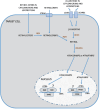Vitamin A - a scoping review for Nordic nutrition Recommendations 2023
- PMID: 38686175
- PMCID: PMC11057411
- DOI: 10.29219/fnr.v67.10229
Vitamin A - a scoping review for Nordic nutrition Recommendations 2023
Abstract
Vitamin A refers to a group of fat-soluble compounds with retinol activity, including all-trans retinol and pro-vitamin A carotenoids. Bioactive compounds include retinal and all-trans retinoic acid with important functions in vision, immune function, growth, and development. The literature search that was performed for the current scoping review yielded a total of seven publications relevant to setting the recommended daily intake for vitamin A. In total, six publications assessed the relationship of serum retinol and/or dietary vitamin A intake with fracture risk (n = 2), cancer (n = 3), and deficiency after bariatric surgery (n = 1). One additional report by the European Food Safety Administration (EFSA) with updated average requirements was included. The outcomes-based systematic reviews and meta-analyses showed positive associations for vitamin A intake and serum retinol with risk of hip fracture. Weak or inconclusive associations were observed for cancer or obesity. One publication by EFSA with updated estimated average requirements and population reference intakes for dietary vitamin A intakes was published in 2015. The EFSA recommendations and estimated average requirements are based on a European reference population, with body weights derived from an assumed body mass index of 22, which might be too low and not representative of the Nordic and Baltic populations, and consequently resulting in lower estimated average requirements and recommendations. In conclusion, there were limited new outcomes-based data for vitamin A and health outcomes.
Keywords: carotenoids; dietary recommendations; retinol; retinol equivalents; vitamin A.
© 2023 Thomas Olsen and Ulf H. Lerner.
Figures


References
-
- EFSA The Panel on Dietetic Products Nutrition and Allergies . Scientific opinion on dietary reference values for vitamin A. EFSA J 2015; 13(3): 4028. doi: 10.2903/j.efsa.2015.4028 - DOI
-
- World Health Organization . Vitamin and mineral requirements in human nutrition. 2nd ed. Geneva: World Health Organization; 2005.
Publication types
LinkOut - more resources
Full Text Sources

